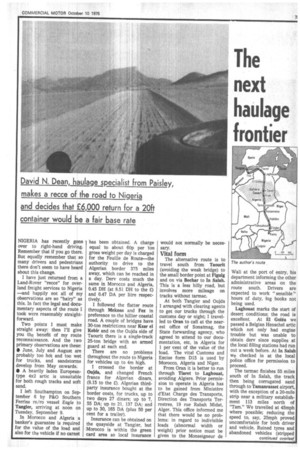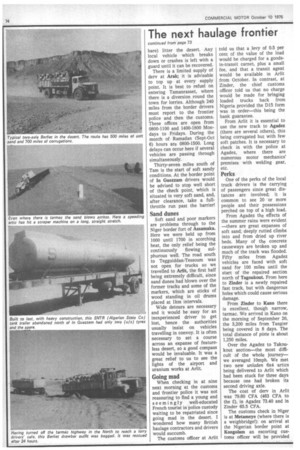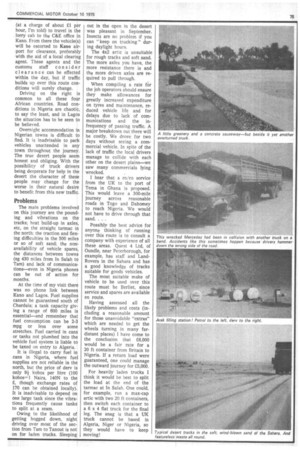The next haulage frontier
Page 75

Page 76

Page 77

If you've noticed an error in this article please click here to report it so we can fix it.
NIGERIA has recently gone over to right-hand driving. Remember that if you go there. But equally remember that so many drivers and pedestrians there don't seem to have heard about this change.
I have just returned from a Land-Rover "recce" for overland freight services to Nigeria —and happily not all of my observations are so "hairy" as this. In fact the legal and documentary aspects of the route I took were reasonably straightforward.
Two points I must make straight away: then I'll give you the benefit of my route reconnaissance. And the two primary observations are these: O June, July and August are probably too hot and too wet for trucks, and sandstorms develop from May onwards.
O A heavily laden Europeantype 4x2 artic is unsuitable for both rough tracks and soft sand.
I left Southampton on September 6 by P&O Southern Ferries ro/ro vessel Eagle to Tangier, arriving at noon on Tuesday, September 9.
In Morocco and Algeria a banker's guarantee is required for the value of the load and also for the vehicle if no carnet has been obtained. A charge equal to about 60p per ton gross weight per day is charged for the Feuille de Route—the authority to drive to the Algerian border 375 miles away, which can be reached in a day. Dery costs much the same in Morocco and Algeria, 0.45 DH (at 8.51 DH to the E) and 0.47 DA per litre respectively.
I followed the flatter route through Meknes and Fez in preference to the hillier coastal road. A couple of bridges have 30-ton restrictions near Ksar el Kebir and on the Oujda side of Taourit there is a single-track 25-ton bridge with an armed guard at each end.
There are no problems throughout the route to Nigeria for vehicles up to 4m high.
I crossed the border at Oujda, and changed French francs for Algerian dinars, (8.15 to the 6). Algerian thirdparty insurance bought at the border costs, for trucks, up to two days 27 dinars; up to 7, 55 DA; up to 21, 137 DA; and up to 30, 165 DA (plus 50 per cent for a trailer).
Insurance can be obtained on the quayside at Tangier, but Morocco is within the green card area so local insurance would not normally be necessary.
Vital form
The alternative route is •to travel south from Taourit (avoiding the weak bridge) to the small border point at Figuig and on via Bechar to In Salah. This is a less hilly road, but involves more mileage on tracks without tarmac.
At both Tangier and Oujda I arranged with clearing agents to get our trucks through the customs day or night; I travelled to Oran to call at the nearest office of Sonatmag, the State forwarding agency, who agreed to attend to our documentation, etc, in Algeria for 1 per cent of the value of the load. The vital Customs and Excise form D15 is used by Morocco, Algeria and Niger.
From Oran it is better to run through Tiaret to Laghouat, avoiding Algiers. Prior permission to operate in Algeria has to be gained from Ministere d'Etat Charge des Transports, Direction des Transports Terrestres, 19 rue Rabah Midat, Alger. This office informed me that there would be no problems: in regard to indivisible loads (abnormal width or weight) prior notice must be given to the Monseigneur de Wali at the port of entry, his department informing the other administrative areas on the route south. Drivers are expected to work " sensible " hours of duty, log books not being used.
Laghouat marks the start of desert conditions; the road is excellent. At El Golea we passed a Belgian Henschel artic which not only had engine trouble but was unable to obtain dery since supplies at the local filling stations had run out a week before. At In Salah we checked in at the local police office for permission to proceed.
The tarmac finishes 55 miles south of In Salah, the track then being corrugated sand through to Tamanrasset airport, with the exception of a 20-mile strip near a military establishment 113 miles north of "Tam." We travelled at 45mph where possible; reducing the speed to, say, 25mph proved uncomfortable for both driver and vehicle. Ruined tyres and abandoned vehicles (stripped bare) litter the desert. Any local vehicle which breaks down or crashes is left with a guard until it can be recovered.
There is a limited supply of dery at Arak; it is advisable to top up at every supply point. It is best to refuel on entering Tamanrasset, where there is a diversion round the town for lorries. Although 240 miles from the border drivers must report to the frontier police and then the customs. These offices are open from 0800-1100 and 1400-1800 Mondays to Fridays. During the month of Ramadan (Sept-Oct 6) hours are 0800-1500. Long delays can occur here if several vehicles are passing through simultaneously.
Thirty-seven miles south of Tam is the start of soft sandy conditions. At the border point of In Guezzam drivers would be advised to stop well short of the check point, which is situated in very soft sand, and, after clearance, take a fullthrottle run past the barrier!
Sand dunes
Soft sand and poor markers are problems through to the Niger border fort of Assamaka. Here we were held up from 1000 until 1700 in scorching heat, the only relief being the continuously flowing sulphurous well. The road south to Tegguiddan-Tessoum was not open for trucks so we travelled to Arlit, the first half being extremely difficult, since sand dunes had blown over the former tracks and some of the markers, which are sticks of wood standing in oil drums placed at lkm intervals.
Wide detours are necessary and it would be easy for an inexperienced driver to get lost, hence the authorities usually insist on vehicles travelling in convoy. It is often necessary to set a course across an expanse of featureless desert, so a good compass would be invaluable. It was a great relief to us to see the lights of the airport and uranium works at Arlit.
Going mad
When checking in at nine next morning at the customs and frontier police it was not reassuring to find a young and seemingly well-educated French tourist in police custody waiting to be repatriated since going mad in the desert. I wondered how many British haulage contractors and drivers would succumb.
The customs officer at Arlit told us that a levy of 0.5 per cent of the value of the load would be charged for a goodsin-transit carnet, plus a small fee, and that a transit agent would be available in Arlit from October. In contrast, at Zinder, the chief customs officer told us that no charge would be made for bringing loaded trucks back from Nigeria provided the D15 form was in order—this being the bank guarantee.
From Arlit it is essential to use the new track to Agadez (there are several others), this being corrugated but with few soft patches. It is necessary to check in with the police at Agadez, where there are numerous motor mechanics' premises with welding gear, etc.
Perks
One of the perks of the local truck drivers is the carrying of passengers since great distances are involved; it is common to see 20 or more people and their possessions perched on top of a high load.
From Agadez the effects of the summer rains were evident —there are great expanses of soft sand, deeply rutted climbs into and from dried up river beds. Many of the concrete causeways are broken up and much of the track was flooded. Fifty miles from Agadez vehicles are faced with soft sand for 100 miles until the start of the repaired section north of Tagoukout. From here to Zinder is a newly repaired fast track, but with dangerous holes which could cause serious damage.
From Zinder to Kano there is excellent, though narrow, tarmac. We arrived in Kano on the morning of September 20, the 3,200 miles from Tangier being covered in 8 days. The total distance of piste is about 1,250 miles.
Over the Agadez to Takoukout section—the most difficult of the whole journey— we averaged lOmph. We met two new unladen 6x4 ,artics being delivered to Arlit which had been stuck for three days because one had broken its second driving axle.
The cost of dery in Arlit was 79.60 CFA (463 CFA to the £), in Agadez 73.40 and in Zinder 65.5 CFA.
The customs check in Niger is at Metameye (where there is a weighbridge!): on arrival at the Nigerian border point at Kongolam an escorting customs officer will be provided (at a charge of about £1 per hour, I'm told) to travel in the • lorry cab to the C&E office in Kano. From there the vehicle(s) will be escorted to Kano airport for clearance, preferably With the aid of a local clearing agent. These agents and the customs staff consider clearance can be effected within the day, but if traffic builds up over this route conditions will surely change.
Driving on the right is common to all these four African countries. Road conditions in Nigeria are chaotic, to say the least, and in Lagos the situation has to be seen to be believed.
Overnight accommodation in Nigerian towns is difficult to find. It is inadvisable to park vehicles unattended in any town throughout the journey. The true desert people seem honest and obliging. With the possibility of truck drivers being desperate for help in the desert the character of these people may change for the worse in their natural desire to benefit from this new traffic.
Problems
The main problems involved on this journey are the pounding and vibrations on the tracks; heat build-up in axles, etc, on the straight tarmac in the north; the traction and flexing difficulties in the 500 miles or so of soft sand; the nonavailability of vehicle spares, the distances between towns (eg 430 miles from In Salah to Tam) and lack of communications—even in Nigeria phones can be out of action for months.
At the time of my visit there was no phone link between Kano and Lagos. Fuel supplies cannot be guaranteed south of Chardaia; a tank capacity giving a range of 600 miles is essential—and remember that fuel consumption can be 2-3 mpg or less over some stretches. Fuel carried in cans or tanks not plumbed into the vehicle fuel system is liable to be taxed on entry to Algeria.
It is illegal to carry fuel in cans in Nigeria, where fuel supplies are not reliable in the north, but the price of dery is only 9i kobos per litre (100 kobos-1 Naira, 140N to the £, though exchange rates of 170 can be obtained locally). It is inadvisable to depend on One large tank since the vibrations frequently cause tanks to split at a seam.
Owing to the likelihood of getting bogged down, night driving over most of the section from Tam to Tanout is not on for laden trucks. Sleeping out in the open in the desert was pleasant in September. Insects are no problem if you can "keep on trucking" during daylight hours.
The 4x2 artic is unsuitable for rough tracks and soft sand. The more axles you have, the more resistance there is and the more driven axles are required to pull through.
When compiling a rate for the job operators should ensure they make allowances for greatly increased expenditure on tyres and maintenance, reduced vehicle life and for delays due to lack of communications and the infrequency of passing traffic. A major breakdown out there will be costly. We drove for two days without seeing a commercial vehicle. In spite of the lack of traffic the local drivers manage to collide with each other on the desert plains—we saw many commercials lying wrecked.
I hear that a ro/ro service from the UK to the port of Tema in Ghana is proposed. This would leave a 300-mile journey across reasonable roads in Togo and Dahomey to reach Nigeria. We would not have to drive through that sand. . .
Possibly the best advice for anyone thinking of running over this route is to consult a company with experience of all these areas. Quest 4 Ltd, of Oundle, near Peterborough, for example, has staff and LandRovers in the Sahara and has a good knowledge of tracks suitable for goods vehicles.
The most suitable make of vehicle to be used over this route must be Berliet, since service and spares are available en route.
Having assessed all the likely problems and costs (including a reasonable amount for those unavoidable "extras" which are needed to get the wheels turning in many fardistant places) I have come to the conclusion that £6,000 would be a fair rate for a 20 ft container from Britain to Nigeria. If a return load were guaranteed, one could manage the outward journey for £5,000.
For heavily laden trucks I think it would be best to split the load at the end of the tarmac at In Salah. One could, for example, run a max-cap artic with two 20 ft containers, then switch each container to a 6 x 4 flat truck for the final leg. The snag is that a UK truck cannot be based in Algeria, Niger or Nigeria, so they would have to keep moving!




































































































































